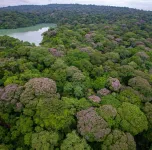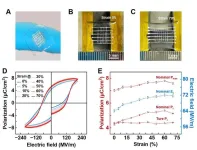(Press-News.org) MINNEAPOLIS/ST. PAUL (08/03/2023) — Published in the International Journal of Obesity, University of Minnesota Medical School and School of Public Health researchers led a study on the relationship between dietary intake and cardiovascular disease risk factors.
Over 20 years, the research team examined people's regular dietary intake, paying particular attention to non-nutritive sweeteners commonly found in artificial sweeteners. They found that long-term consumption of aspartame, saccharin and diet beverages were linked to increased fat stores in the abdomen and fat within muscle. However, the study found no significant association between the artificial sweetener sucralose and these measures of fat volume.
"This study showed that habitual, long-term intake of total and individual artificial sweetener intakes are related to greater volumes of adipose tissue, commonly known as body fat," said Brian Steffen, PhD, MSCR, a professor in the Department of Surgery at the U of M Medical School and co-investigator on the funded grant. "This was found even after accounting for other factors, including how much a person eats or the quality of one's diet.”
The study's findings raise concerns about the recommendations from the American Diabetes Association and the American Heart Association that promote the replacement of added sugars with artificial sweeteners. Based on their results, the researchers recommend considering alternative approaches, as long-term artificial sweetener consumption may have potential health consequences.
“This is an especially timely study, given the World Health Organization’s recent warning of the potential health risks of aspartame,” said Lyn Steffen, PhD, MPH, a professor in the School of Public Health and principal investigator on the study. “These findings underscore the importance of finding alternatives to artificial sweeteners in foods and beverages, especially since these added sweeteners may have negative health consequences.”
The researchers emphasize the need for more studies to better understand the connection between artificial sweetener intake and increased body fat. Further research is warranted to explore the underlying mechanisms and gain clearer insights into how dietary habits affect metabolic health.
The study was funded by the National Institutes of Health and the National Heart, Lung and Blood Institute under grant numbers R21 HL135300 and R01 HL150053, as well as by contracts from the NIH/NHLBI funding the four field centers.
###
About the University of Minnesota Medical School
The University of Minnesota Medical School is at the forefront of learning and discovery, transforming medical care and educating the next generation of physicians. Our graduates and faculty produce high-impact biomedical research and advance the practice of medicine. We acknowledge that the U of M Medical School, both the Twin Cities campus and Duluth campus, is located on traditional, ancestral and contemporary lands of the Dakota and the Ojibwe, and scores of other Indigenous people, and we affirm our commitment to tribal communities and their sovereignty as we seek to improve and strengthen our relations with tribal nations. For more information about the U of M Medical School, please visit med.umn.edu.
For media requests, please contact:
Ezra Xiong
Communications Specialist
xion1913@umn.edu
University of Minnesota Medical School
END
University of Minnesota-led study links long-term artificial sweetener intake to increased body fat adipose tissue volume
2023-08-03
ELSE PRESS RELEASES FROM THIS DATE:
Deep learning for new protein design
2023-08-03
The key to understanding proteins — such as those that govern cancer, COVID-19, and other diseases — is quite simple. Identify their chemical structure and find which other proteins can bind to them. But there’s a catch.
“The search space for proteins is enormous,” said Brian Coventry, a research scientist with the Institute for Protein Design, University of Washington and The Howard Hughes Medical Institute.
A protein studied by his lab typically is made of 65 amino acids, and ...
Scientists uncover a startling—and exploitable—coordination of gene expression in tumors
2023-08-03
AUGUST 3, 2023, NEW YORK – A Ludwig Cancer Research study has identified a pair of genes whose expression by a type of immune cell within tumors is predictive of outcomes for cancer patients and is linked to a vast network of gene expression programs, engaged by multiple cell types in the tumor microenvironment, that control human cancers.
Researchers led by Ludwig Lausanne’s Mikaël Pittet report in the current issue of Science that patients with higher expression of the gene CXCL9 in their tumor-associated macrophages had far better clinical outcomes than those with higher expression of a gene named SPP1 by the immune cells. Macrophages expressing the former ...
Fatal heart disease has plummeted since 1990, but progress has stalled
2023-08-03
After decades of decline, fatal coronary heart disease may rise again unless Americans modify three major risk factors: smoking, drinking, and obesity.
A Rutgers study just published in American Heart Journal found that deaths from coronary heart disease among people ages 25 to 84 dropped to 236,953 in 2019 from 397,623 in 1990, even though Americans’ median age increased to 38 from 33 over the last three decades.
Between 1990 and 2019, the US age-standardized coronary heart disease mortality rate per 100,000 fell from 210.5 to 66.8 for females (4 percent decline per year) and from 442.4 to 156.7 for males (3.7 percent decline per year). However, the decline has slowed significantly ...
UCF, MIT designing technology to fight bacterial infections, improve aquaculture farming
2023-08-03
UCF, MIT Designing Technology To Fight Bacterial Infections, Improve Aquaculture Farming
BY SUHTLING WONG | AUGUST 3, 2023 11:11 AM
UCF and MIT researchers are using farm-raised seafood as a model to create new technologies that fight pathogenic bacteria.
University of Central College of Medicine microbiologist Dr. Salvador Almagro-Moreno and Massachusetts Institute of Technology's Dr. Otto Cordero were recently awarded a grant from the National Science Foundation to create synthetic microbiomes – communities of microorganisms – that will better protect aquatic environments from bacteria.
The team ...
Researchers discuss the ethical challenges of studying DNA from a 18th–19th century African American community
2023-08-03
A population genetics team recently identified the genetic relationship between over 40,000 23andMe users and a population of enslaved and free African Americans that lived in Catoctin Furnace, Maryland between 1776–1850. Over the course of this study, the researchers considered how best to inform descendants and other genetic relatives of their genetic connection to the site. The group has published their considerations and the ethical questions they have encountered on August 3rd in the American Journal of Human Genetics.
“This study required us to consider several ethical issues that had not been explicitly addressed in the existing literature ...
Tropical trees use social distancing to maintain biodiversity
2023-08-03
Tropical forests often harbor hundreds of species of trees in a square mile, but scientists often struggle to understand how such a diversity of species can coexist. In a study published in Science, researchers at The University of Texas at Austin have provided new insights into the answer by uncovering a key characteristic of the spatial distribution of adult trees.
Combining computational modeling with data collected during a 30-year period, the researchers discovered that adult trees in a Panamanian forest are three times as distant from other adults of the same species as what the proverbial “the apple doesn’t fall far from ...
Ferroelectric material is now elastic
2023-08-03
A research group led by Prof. LI Runwei at the Ningbo Institute of Materials Technology and Engineering (NIMTE) of the Chinese Academy of Sciences (CAS) have proposed a "slight crosslinking" method that imparts elastic recovery to ferroelectric materials.
The study was published in Science.
Ferroelectric materials are very useful for applications such as data storage and processing, sensing, energy conversion, and optoelectronics, etc., making them highly desirable in mobile phones, tablets and other ...
Editorial: Turning the tide on obesity?
2023-08-03
In an Editorial, Cynthia Bulik and Andrew Hardaway highlight the recent advances in medical treatments for obesity and weight loss. “With the emergence of new, highly effective weight-loss drugs, might the ‘fat decades’ become a closed chapter in the history of public health?” ask the authors. The “obesity epidemic” is a global health concern, with more than a billion people affected by obesity and many more overweight. Although various environmental, biological, and behavioral factors have been implicated in obesity, few consistently effective treatments exist for the disease. Recently, however, new weight-loss ...
Compensation for damages can and should address social and cultural impacts
2023-08-03
In this Policy Forum, Robin Gregory and colleagues highlight how a suite of methodological approaches can be used to bring less tangible social and cultural losses that marginalized groups incur into the formal compensation assessment framework. “Though the issues and approaches we describe are applicable in many contexts,” the authors write, “we illustrate them … with a focus on Indigenous communities, for whom the neglect of social and cultural losses in assessments of compensation ...
Adult tropical trees of the same species grow farther apart than factors like seed dispersal limits can explain
2023-08-03
Tropical trees distance themselves from members of their own species more than they do other species, a new study shows. What’s more, trees of the same species exist at distances farther apart than would be expected by chance or the limits of seed dispersal. The results reveal pervasive within-species spatial repulsion in adult trees, providing new insights into the ecological dynamics that stabilize species diversity and enable the exceptionally high diversity of tropical forests. Tropical forests host an unusually high diversity of tree species. For example, some tropical forests contain more than 250 tree species per hectare. However, how hundreds of species coexist on relatively small ...



